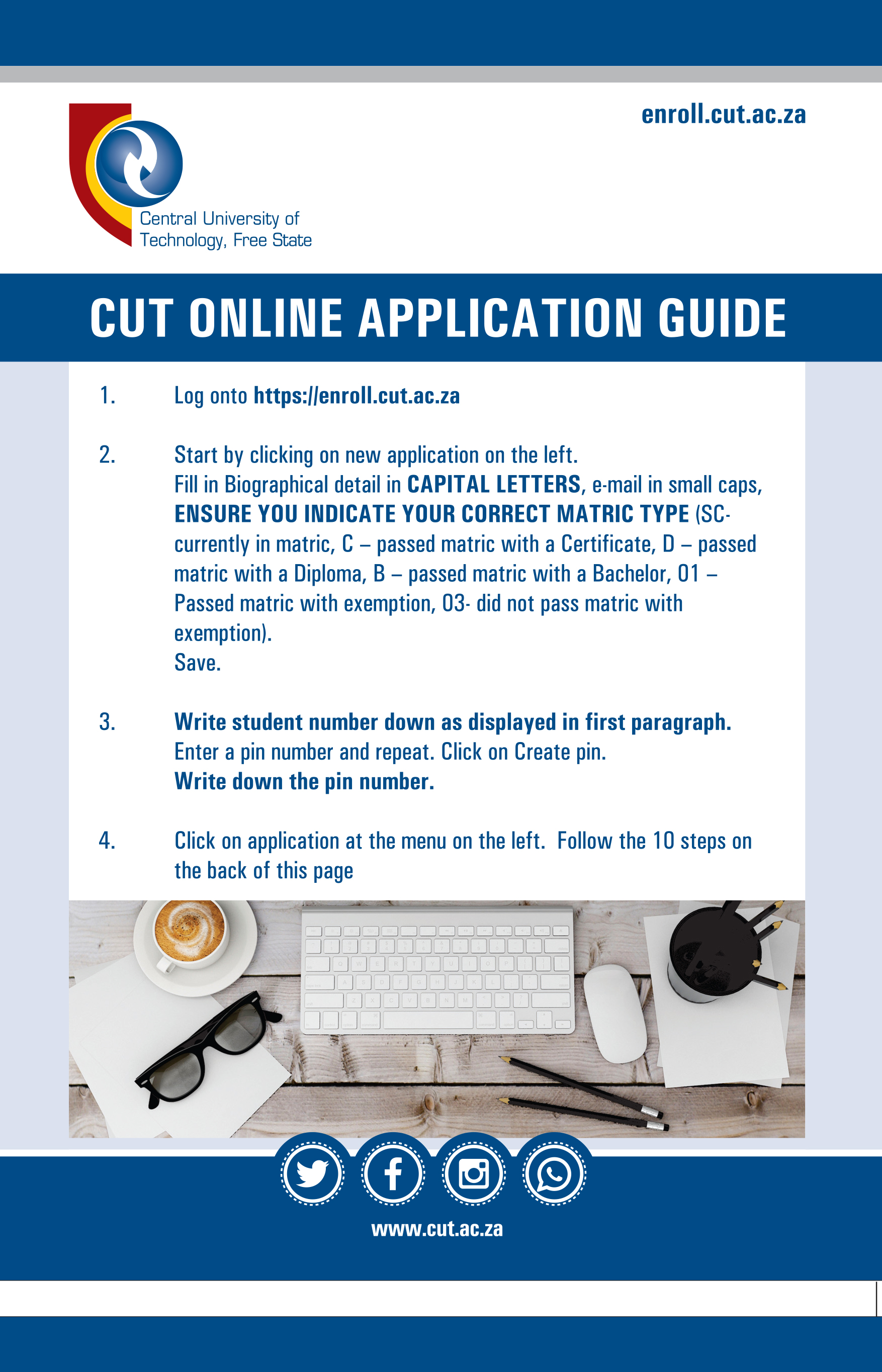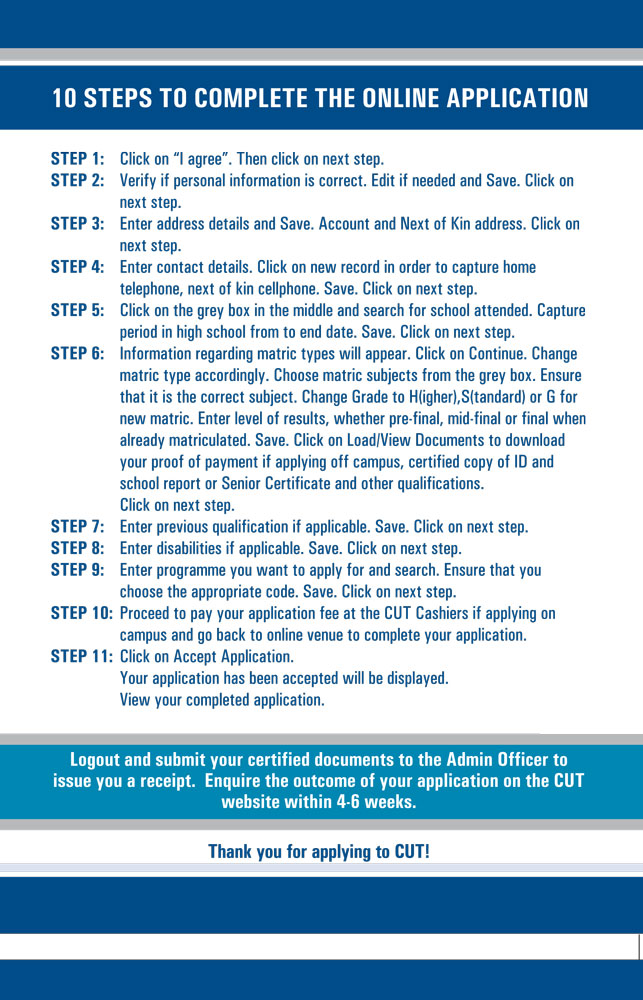

Download or open the Online Application Guide, and follow the steps in the PDF document to complete the CUT application (includes screenshots of the system).
1. Online Application guide (PDF)
2. Go to Online Application
Admission Process At CUT For 2026 Intake Cycles
- Applications for the following year will open in May/June of each year; closing date is end of August.
- Applications for the second semester will open in March/April of each year; closing date is end of May. Please note only selected programmes have a second semester intake.
Specific Admission information
An application fee, as stipulated in the admission regulations of the CUT, must be paid before the deadline specified in the admission regulations.
Prospective students must provide the Assistant Registrar: Academic Structure and Student Enrolment Services with their completed application forms for admission to the CUT as early as possible in the preceding academic year or semester. A non-refundable application fee is payable with each application for admission.
Once the Academic Structure and Student Enrolment Services Unit have processed the applications, a selection list is drawn up and forwarded to the various faculties.
Upon receipt of the selection lists, the head of the department divide the applications into three (3) categories, namely:
- Applicants who meet all the admission requirements;
- Applicants to be subjected to the testing of potential;
- Applicants who are considered academically unsuccessful.
Applicants falling into the first category are notified in writing by the Academic Structure and Student Enrolment Services Unit that their applications for admission to the CUT have been successful.
The unsuccessful applicants falling into the third category are notified in writing by the Academic Structure and Student Enrolment Services Unit that their applications for admission to the CUT have been unsuccessful.
Applicants falling into the second category are notified in writing by the Academic Structure and Student Enrolment Services Unit that their applications for admission are subject to the testing of potential. The date, time and place of such testing will be clearly indicated.
The testing of potential proceeds as follows:
- The applicant reports on the date and at the time and place indicated in the letter.
- The testing, as described in the admission regulations of the CUT, is administered on this occasion by the Wellness Centre.
- The results of the test are arranged in hierarchical order as soon as possible after the test.
- The Wellness Centre make these results available to the various faculties, after which the relevant department heads make a final selection of applicants for particular learning programmes.s
Candidates who have successfully completed the selection process are notified in writing of their admission to the CUT by the Academic Structure and Student Enrolment Services Unit, however, applicants falling into the first category will receive preference with regard to placement in learning programmes, except where the Senate determines otherwise.
The names of candidates who have completed the test with regard to potential and have not been granted admission are placed on a waiting-list to be reconsidered during a subsequent evaluation opportunity. Such candidates will receive a letter from the Academic Structure and Student Enrolment Services Unit informing them that their applications for admission have been unsuccessful after the final placement in the various learning programmes.
In the case of candidates applying for admission to the learning programmes: Hospitality Management, Marketing, Emergency Medical Care, Tourism Management, Dental Assistance, Language Practice and Art and Design; it is expected that, in addition to the testing of potential, the applicants will undergo one or more of the following procedures before final selection and acceptance can proceed, namely:
- Psychometric testing/evaluation
- Portfolio submission
- Interview
- Completion of a questionnaire
- Assessment of practical skills
- Any other process, as approved by the Senate
Upon receipt of an official letter from the Academic Structure and Student Enrolment Services Unit to the effect that the candidate concerned has been granted admission to the CUT, the candidate must indicate in writing, before or on the date stipulated in the letter, whether he/she accepts the offer of admission. Failure to do so could lead to the expiry of the said offer.
Additional procedures designed to facilitate the execution of the standard procedure may be announced by the Senate in due time
Standard administrative procedures and forms used in the event of changes to the agreement concluded with the CUT.
Upon registration as a student at the CUT, the student signs a statement in terms of section 3.2 (i) (6) of chapter 4 of the CUT calendar, declaring that he/she will immediately notify the Assistant Registrar: Academic Structure and Student Enrolment Services in writing on the prescribed LS 149 form (available from the Assistant Registrar: Academic Structure and Student Enrolment Services) of any change of address.
Should any change to a learning programme or subject be made, the student must supply the Academic Structure and Student Enrolment Services Unit with the prescribed LS 151 form (available from the Assistant Registrar: Academic Structure and Student Enrolment Services), completed in triplicate and signed by the relevant programme head, before the predetermined deadline.
In the event of the suspension of studies, the prescribed LS 150 form (available from the Assistant Registrar: Academic Structure and Student Enrolment Services), signed by the head of the department concerned, must be delivered to the Academic Structure and Student Enrolment Services Unit.
In the event of a change of residence or the cancellation of board and lodging, the prescribed LS 150 form, signed by the Residence Manager of the relevant residence, must be delivered to the Academic Structure and Student Enrolment Services Unit. If the LS 150 form is not submitted before the deadline, no discount/refund of fees will be granted.
Students at the regional learning centres must complete the prescribed LS 154 form (available from the Assistant Registrar: Academic Structure and Student Enrolment Services) to apply for a student card, and must forward this form together with a recent identity photograph to the CUT.
If a student should lose/misplace his/her student card, the student must reapply for a new card immediately by means of the prescribed LS 154 form (available from the Assistant Registrar: Academic Structure and Student Enrolment Services), since positive identification is necessary for access to all facilities on all campuses.
Need Information or Confused about Something ?
Ask a QuestionRelated Resources
Sponsored Guide
Complete Guide to NSFAS Online Loan Application for South African Students (2025)
If you are a South African student looking to pursue higher education but are facing financial difficulties, the National Student Financial Aid Scheme (NSFAS) is one of the most accessible funding options available. NSFAS provides financial aid in the form of bursaries and loans to qualifying students at public universities and TVET colleges in South Africa.
This guide will walk you through everything you need to know about the NSFAS loan application process, from eligibility requirements to application steps and frequently asked questions.
📌 What is NSFAS?
The National Student Financial Aid Scheme (NSFAS) is a government-funded financial aid scheme aimed at helping students from low- and middle-income households to access tertiary education without the burden of upfront fees.
NSFAS offers both bursaries and income-contingent loans:
- Bursaries: For eligible students who meet academic and household income criteria (especially for TVET and university students).
- Loans: For students who do not meet all bursary criteria or who are pursuing postgraduate qualifications not funded under bursary schemes.
✅ Who Qualifies for an NSFAS Loan?
To qualify for an NSFAS loan (especially for postgraduate students or programs not funded under the bursary system), you must:
- Be a South African citizen.
- Be financially needy, with a household income of less than R350,000 per year.
- Have a valid South African ID.
- Be enrolled or accepted to study at a public university or TVET college.
- Not be funded through another bursary program that covers all expenses.
- Maintain satisfactory academic progress (returning students).
📚 Courses Funded by NSFAS
NSFAS primarily funds undergraduate qualifications, but certain postgraduate programs (e.g., PGCE, postgraduate diplomas in education, and professional courses like LLB) may be considered under the NSFAS loan scheme, not bursaries.
If you’re studying:
- Undergraduate degree or diploma: You are likely eligible for a full NSFAS bursary.
- Postgraduate study: You may qualify for a loan, depending on the course and funding availability.
📄 Required Documents for NSFAS Application
When applying, make sure you have the following documents scanned and ready:
- Certified copy of your South African ID or Smart Card.
- Parent(s) or guardian(s) ID documents.
- Proof of income (latest payslips, UIF, or affidavit if unemployed).
- Consent Form signed by your parent(s)/guardian(s) to allow NSFAS to verify income.
- Proof of registration or acceptance at a public institution.
- Academic transcripts (for continuing or postgraduate students).
🖥️ How to Apply for an NSFAS Loan Online
Step-by-Step NSFAS Online Application Process (2025)
-
Visit the NSFAS Website
Go to: https://www.nsfas.org.za
-
Create an Account
- Click on “MyNSFAS” and register your profile.
- You’ll need a valid email address and South African cellphone number.
- Choose a strong password and verify your account via email or SMS.
-
Login and Start the Application
- After registration, log in to your MyNSFAS account.
- Click on “Apply” to begin a new application.
-
Fill in Your Personal Details
- Input your ID number, name, surname, and other details exactly as they appear on your ID.
- Provide household income information and living arrangements.
-
Upload Required Documents
- Upload all supporting documents in PDF or JPEG format.
- Each document must be clear and under the size limit specified.
-
Submit Your Application
- Review your application for accuracy.
- Click “Submit” and wait for a confirmation message.
-
Track Your Application
- Log in regularly to check your application status.
- You will be notified via SMS and email at each stage of the process.
🗓️ Important NSFAS Dates (2025)
- Application Opening Date: September 1, 2025
- Application Deadline: January 31, 2026
- Appeals Period: February 2026 (if rejected)
- Disbursement: After registration and approval
Note: Dates are subject to change; always confirm on the official NSFAS website.
💸 What Does the NSFAS Loan Cover?
NSFAS funding typically includes:
- Tuition fees
- Registration fees
- Accommodation (if living away from home)
- Meals and transport
- Learning materials (e.g., textbooks)
For loans, repayment is only required once you start working and earn above a threshold (around R30,000 annually, but subject to change).
🔄 NSFAS Loan Repayment
Repayments are:
- Income-contingent – you only repay when you can afford to.
- Administered by DHET (Department of Higher Education and Training).
- Interest-bearing, but interest rates are low and favorable.
You can also apply for a partial loan conversion to a bursary if you perform well academically.
🔁 How to Appeal a Rejected NSFAS Application
If your application is rejected, you may submit an appeal via your MyNSFAS portal:
- Log into your MyNSFAS account.
- Click on “Track Funding Progress”.
- If rejected, click on “Submit Appeal”.
- Upload any missing or corrected documents.
- Provide a clear explanation or motivation.
📱 NSFAS Contact Information
- Website: https://www.nsfas.org.za
- Email: info@nsfas.org.za
- Toll-Free Number: 08000 67327 (Monday–Friday, 8 AM–5 PM)
- Twitter: @myNSFAS
- Facebook: NSFAS
📝 Final Tips Before Applying
- Apply early to avoid system overload near the deadline.
- Use your own email and cellphone number (do not use someone else’s).
- Double-check that all your documents are certified and legible.
- Keep a copy of your submission confirmation for reference.
By following this guide, you can confidently apply for NSFAS funding and move one step closer to achieving your academic and career dreams—without the burden of immediate financial pressure.